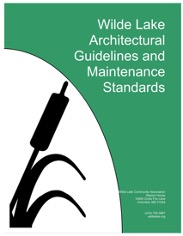

1.1 A High-Quality Community
1.2 What are the Covenants?
2.0 THE ARCHITECTURAL REVIEW PROCESS
2.1 The Residential Architectural Committee (RAC)
2.2 The Architectural Committee (AC)
2.3 Fast Track Process
2.4 Additional Approvals
2.5 A Few Words on Covenant Compliance
2.6 General Policy for Access to Village Documents
4.1 Accessibility -- Handrails, Ramps, Wheelchair / Stair Lifts
4.2 Additions
4.3 Air Conditioning and Heating Units
4.4 Animal Shelters and Dog Runs
4.5 Antennas and Satellite Dishes
4.6 Attic Ventilators
4.7 Awnings and Trellises
4.8 Basketball Equipment
4.9 Chimneys and Flues
4.10 Clotheslines
4.11 Compost Bins
4.12 Decks
4.13 Doors and Windows (Including Garage Doors & Storm Doors)
4.14 Driveways
4.15 Electric Car Charging Stations
4.16 Fencing
4.17 Flags and Banners
4.18 Fuel Storage Tanks
4.19 Gazebos
4.20 Grills
4.21 Gutters
4.22 Hot Tubs and Whirlpools
4.23 In-Home Businesses
4.24 Landscaping
4.25 Lawn Ornaments
4.26 Light Fixtures
4.27 Patios and Walkways
4.28 Play Equipment
4.29 Ponds
4.30 Privacy Screens
4.31 Radon Mitigation Equipment
4.32 Rain Barrels
4.33 Rental Property Advisory
4.34 Retaining Walls
4.35 Roofing
4.36 Security Cameras
4.37 Sheds
4.38 Siding
4.39 Signs
4.40 Skylights
4.41 Solar Panels
4.42 Swimming Pools
4.43 Teardown/New Construction
4.44 Tree Removal
4.45 Vegetable Gardens
| Revision Number | Date | Reason for Revision |
| 1 | October 14, 2005 | General Revision |
| 2 | November 8, 2005 | Addition of Teardown Policy |
| 3 | March 7, 2011 | Fast Track Process |
| 4 | February 3, 2014 | Dumpsters, Temp Storage |
| 5 | August 4, 2014 | Fencing, Dumpsters, Temp Storage |
| 6 | February 6, 2015 | Wireless (cellular) antennas |
| 7 | September 12, 2022 | General Revision |
The Wilde Lake Community Association, in conjunction with the Wilde Lake Village Board and the Wilde Lake Architectural Committee (AC), are pleased to present a detailed set of revised and updated guidelines for maintenance standards, exterior alterations, and in-home businesses for residential and some commercial property in the Village of Wilde Lake. These guidelines are designed to provide parameters for maintenance, to help with plans to alter the exterior appearance of homes, and to establish acceptable home industries and professions. The intent of these guidelines, and the Covenants upon which they are based, is to ensure that the appearance of our village is maintained while allowing Wilde Lake residents the fullest enjoyment of their properties.
This set of guidelines provides answers to your questions about how the Wilde Lake Architectural Committee operates. The Committee is available to assist residents in developing and, if necessary, modifying their applications so that proposed changes fall within these guidelines. Alterations and in-home businesses approved by the Wilde Lake Architectural Committee may also be subject to local association covenants or restrictions and to the additional requirements of Howard County. It is the homeowner's responsibility to ensure compliance with all applicable restrictions.
Questions concerning these guidelines or the Wilde Lake Village Covenants should be directed to the Covenant Advisor at the village office in Slayton House. ([email protected], 410-730-3987)
One of the reasons Wilde Lake is a special place is that all property is subject to the Wilde Lake Village Covenants, designed to:
These objectives are accomplished through the architectural review system and covenant enforcement. This user's guide provides useful information for residents.
The planned community of Wilde Lake has a variety of styles of detached single-family homes, townhouses, condominiums, and apartment complexes.
While the architectural integrity of the village is important, Wilde Lake is now more than 50 years old. What were acceptable building practices 50 years ago may not be today, just as what is acceptable today may not be five years from now. Colors and materials available 50 years ago may not be available now. Today's popular design and available materials may differ from the developer's original concept for Wilde Lake.
Keep in mind that these are guidelines and not necessarily rules. If the only issues were related strictly to design and only to what is set forth in these guidelines, Architectural Committee (AC) members could perform their jobs easily. What makes their duties challenging is the need to balance the rights and expectations of property owners with those of their neighbors and the community.
The Wilde Lake Village Covenants, which establish the authority for the Architectural Committee, are a binding legal contract between the Village of Wilde Lake and all property owners.
The Covenants give the Architectural Committee the responsibility to set rules and procedures for architectural controls. There are similar Covenants for each of the other Villages in Columbia.
The Covenants "run with the land" as part of your deed of ownership and cannot be changed. When the development period of our Village was completed, the Covenants became a contract between the Wilde Lake Community Association, as represented by its elected Board of Directors (the "Village Board"), and the residents.
For further information, please see Article VIII GENERAL COVENANTS AND RESTRICTIONS of the Wilde Lake Village Covenants -- DEED, AGREEMENT AND DECLARATION.
The Wilde Lake Village Covenants assure property owners and residents a minimum standard of architectural design and property maintenance throughout the village. These Covenants enable residents (by way of the complaint process), as well as the Wilde Lake Community Association, to have input into decision making and the enforcement of the Covenants. (See the Maintenance Standards Section of this document.)
Copies of the Covenants are available at Slayton House, 10400 Cross Fox Lane; from the Wilde Lake Community Association website (requires Adobe Reader); or via email from the Covenant Advisor, [email protected]
Covenants should be issued to new homeowners at the transfer of property ownership.
^ top ^
2.0 THE ARCHITECTURAL REVIEW PROCESS
Any exterior alteration that materially changes the appearance of a structure located in the Village of Wilde Lake must be approved through the architectural review process. The following section describes this process.
2.1 The Residential Architectural Committee (RAC)
The Wilde Lake Village Board appoints a minimum of five volunteer Wilde Lake residents as the Resident Architectural Committee. The RAC meetings are held every second and fourth Tuesday of the month, excepting holidays, and are open to the public.
The RAC is the initial committee to review the applications for exterior alterations:
Public notice of applications coming up for consideration by the RAC occurs in the weekly Wilde Lake E-Newsletter, available in the What's Happening section of the WLCA website and on the published agenda in the Covenants section of the WLCA website. The Village Covenant Advisor can be contacted at 410-730-3987 or [email protected] to answer questions about applications coming before the RAC.
2.2 The Architectural Committee (AC)
The Architectural Committee consists of five members of the Wilde Lake Village Board. The Architectural Committee shall designate a member of the AC as the AC Liaison. This member of the AC shall be responsible for making a final determination on all Resident Architectural Committee (RAC) recommendations, based upon the Covenants and these Guidelines. The AC Liaison will make a site visit prior to making a final determination on any application in which there is a recommendation to disapprove, there is not a unanimous RAC vote, or there is neighbor opposition. The AC Liaison will process residential applications within five business days of the RAC recommendation. Any applicant who is not satisfied with the RAC recommendation and AC Liaison decision may, within ten days of the decision, request in writing or email a full Architectural Committee review of the decision. That decision will be final and binding.
For certain residential exterior alterations, a Fast Track application review process is available to shorten processing time. The standard Application for Exterior Alteration form is also used for Fast Track requests, and it must be complete at the time of submission for Fast Track consideration.
Under given criteria, as described elsewhere in this Wilde Lake Architectural Guidelines and Maintenance Standards, the following alteration categories qualify for Fast Track:
Upon receipt of applications for Fast Track review, the Covenant Advisor will certify that the application meets the eligibility criteria for Fast Track process. If the project meets a Fast Track criterion and if the application is complete, it will be reviewed by the Architectural Committee Liaison, and the applicant will be notified of the decision by email (or phone if no email address is provided) within five business days.
Please note that Fast Track may not be available at certain times, such as holidays, due to scheduling difficulties. If an application cannot be reviewed under the Fast Track process, the applicant will be notified, and it will be scheduled on a regular Residential Architectural Committee agenda. The AC Liaison has the right to request that any application submitted under Fast Track be first reviewed by the full RAC before making a final decision.
The property owner is responsible for obtaining all required Howard County approvals. Applicants should contact the Department of Inspections, Licenses and Permits (410-313-2455) to verify and obtain the required permits before beginning any work.
Applicants who live in a townhouse or condominium community having a Homeowners Association (HOA) may need to obtain approval for exterior alterations. Check with your HOA to determine if this is the case. Approval by the Wilde Lake Architectural Committee is independent of HOA approval and does not imply or supersede HOA approval, nor does HOA approval substitute for Architectural Committee approval.
2.5 A Few Words on Covenant Compliance
Wilde Lake Covenant compliance is characterized by the following:
A Complaint Driven Process
The Wilde Lake Community Association (WLCA) does not employ a full-time person to inspect the Village for Covenant violations. Instead, the WLCA relies on the residents of Wilde Lake to maintain their properties. Covenant enforcement can only be effective if residents are responsive to observed violations.
The process is simple and completely anonymous. If a resident observes what she or he perceives is a Covenant violation, the resident may contact the Wilde Lake Covenant Advisor (410-730-3987, [email protected]) and describe the nature and location of the perceived violation. The Covenant Advisor will visit the property in question and determine if the condition is in fact a violation.
If the property is found to be in violation of the Covenants, the Covenant Advisor will contact the owner of the property. In most cases, the owner and Covenant Advisor work out a means to bring the property into compliance.
Columbia Association Architectural Resource Committee
In those cases where a property owner does not correct a Covenant violation within a reasonable amount of time, the case is forwarded to the Columbia Association Architectural Resource Committee (ARC). The ARC is a committee chartered by the Columbia Association and is not part of the Wilde Lake Community Association. It recommends whether the Columbia Association should join a legal suit against the owner whose property is in violation of the Covenants.
The Columbia Association ARC will only consider Covenant violation cases in which the property owner has been given a reasonable chance to correct a violation. If the ARC decides the case is valid, Columbia Association will proceed to bring legal action against the property owner. If the ARC does not accept the case, it is referred back to the Village.
Letter of Compliance
The Wilde Lake Covenant Advisor inspects properties for compliance for property owners (or their duly authorized agents) who request inspection by submitting the Letter of Compliance Request Form available online (requires Adobe Reader). The Letter of Compliance states that on the date of review, the property was found to not have any outstanding Covenant or maintenance violations. In addition, the Covenant Advisor will check to ensure that all exterior alterations have Wilde Lake Architectural Committee approval.
A Letter of Compliance is most frequently requested when a property is being sold as buyers may want to know there are no Covenant violations.
After inspection by the Covenant Advisor, the Owner will receive a letter either stating the property is in compliance or information detailing what items must be addressed to be in compliance.
The list of maintenance standards described in Section 3 serves as a partial checklist for inspecting properties in response to a Request for Letter of Compliance.
2.6 General Policy for Access to Village Documents
* Prices quoted are subject to change without notice.
^ top ^
The maintenance of residential property is the responsibility of every property owner. Each property owner has the following responsibilities:
Residents should also take cooperative responsibility for the maintenance of their cul-de-sac. Neither Howard County nor Columbia Association maintains cul-de-sacs.
Bulk items (boxes and bins, ladders, lawn-care equipment, for example) are not to be stored or accumulated on any lot. Store bulk items out of sight or discard them. Do not cover items with a brightly colored tarp.
Driveways that are deteriorating should be repaired or replaced.
Fences should be in good repair, standing straight with no broken or missing boards and no peeling paint. An approved application is required for new fences, removing fences in some cases, or a change in style.
Grass should be mowed and trimmed on a regular basis during growing season. Tall weeds and overgrown vines should be trimmed or removed.
Gutters and downspouts should be in place and secure, with no peeling paint. Gutters should be clean of tree debris and dirt. An approved application may be needed for new gutters.
Drainage, overflow, and stormwater runoff must not be discharged directly onto neighboring properties. For single-family detached residences (not townhomes) excess water should discharge at least six feet within the homeowner's property lines.
When possible, downspouts should not discharge directly onto driveways, sidewalks, or impermeable surfaces, but rather into grass or landscaped beds.
Holiday decorations must be removed within 14 days after a holiday.
^ top ^
House numbers must be on every building or house and must be easily visible from the street. Do not paint house numbers on the curb (Howard County does not allow house numbers to be painted on curbs). An approved application may be needed for new or replacement house numbers.
3.8 Lampposts & Exterior Light Fixtures
Lampposts should stand straight and should be free of rust. Light fixtures should not be crooked or have missing or broken bulb coverings. Globes to cover the light bulb should always be in place. An approved application may be needed when replacing or adding new fixtures. Lawn, sidewalk, roof and gutters should be cleared of leaves and debris on a regular basis during the appropriate seasons. Raking leaves and debris into the street and/or open space or ravines is prohibited. Residents may leave fallen leaves below trees and in garden beds, mow over the leaves that fall onto lawn and leave them to fertilize the grass, rake them under shrubs and trees, use them to help smother turf when creating new garden patches, compost them in an onsite bin, or send them to Alpha Ridge landfill for composting. Leaf piles should not be covered with a tarp. An approved application may be required for compost bins. Mold, mildew, and algae should be removed from all structures. There should be no peeling paint or rotted wood on structures. An approved application for color change is required. Patios and/or walkways that are deteriorating or damaged should be repaired or replaced. An approved application may be required. The roof should be in good repair and of all one color. There should not be any accumulation of debris on the roof. An approved application may be required for a new roof. ^ top ^ Screens should be in good repair and fit properly. Shrubs should not be overgrown for the size of the structure. Dead shrubs should be removed and disposed of. An approved application is required for planting single species shrubs that are to be used as a hedge. Siding should be securely intact and free of mold, discoloration, or dirt. An approved application is needed for changing the color or style of siding. Sidewalks should be in good repair with no crumbling or heaving. The maintenance, including snow removal, of sidewalks is the responsibility of the adjoining property owner under Howard County law. This means that if your lot abuts any section of a sidewalk, you are responsible for that portion of the sidewalk. Maintenance of the grass area between sidewalk and curb are also the adjacent property owner's responsibility and should include appropriate mowing, trimming, weeding in the same manner and frequency as regular lawn care. (Sidewalks damaged by street trees may be repaired by the county.) FOR MORE INFORMATION ON SIDEWALK REPAIR AND HOWARD COUNTY POLICIES CALL 410-313-2330. Brightly colored tarps are not allowed in the open on any lot. 3.19 Trash, Trash Containers and Recyclables: Trash and recycling containers should have secure lids on them. Except for scheduled collection days, containers should not be stored in view. No refuse, trash or bulk items/materials may be accumulated or stored on any lot. Trash and recycling containers should not be put out any earlier than the evening prior to pick-up day and should be stored out of sight by sunset of the collection day. Dead trees or branches may be removed from the property, however, written permission is required from the Columbia Association to remove a tree 6 inches or more in diameter measured two feet above the ground. A Tree Removal Request can be found in the Forms and Applications section of WLCA's site and should be submitted to CA Open Space at [email protected] (410-312-6330). An arborist will inspect the tree(s). If the tree is approved for removal, the resident will be notified by email or mail. Problems with street trees should be brought to the attention of Howard County Bureau of Highways by submitting a request through Howard County's TellHoCo website or by calling 410-313-7450. Boats, trailers, inoperable vehicles, commercial trucks, vehicles without current registration, or any similar items are not allowed in the open on any lot. Vehicles may only be parked on driveways, parking pads or the street. Vehicles may not be parked on the lawn or other areas of the lot. Campers, recreational vehicles and motor homes may not be stored in the open on any lot. Storage in open carports is not permitted. It is the responsibility of owners to find alternative storage locations. Renovation of vehicles or major repairs may not be undertaken except in enclosed garages. Only minor emergency repairs such as changing a tire or battery, etc. are permitted in the open. Window frames and sills should be kept in good repair. Panes that are broken or fogged due to broken seals should be repaired or replaced. Woodpiles should be neatly stacked inconspicuously and never covered with a brightly colored tarp. The above list may not cover every standard of good property maintenance. ^ top ^4.0 EXTERIOR ALTERATION GUIDELINES
The purpose of the Guidelines is to aid residents in preparing applications to the Architectural Committee.
These guidelines are adhered to in most instances. However, lot configuration, land topography or other mitigating circumstances may be considered in the approval process. Approval of an exterior alteration on one lot does not mean that alteration is acceptable on another lot.
4.1 Accessibility -- Handrails, Ramps, Wheelchair / Stair Lifts
These guidelines are intended to aid residents' mobility while remaining in their homes.
An application is required when a new handrail, ramp, and/or wheelchair / stair lift is installed or when modifications are made to existing accessibility structures.
Applications must include:
All types of accessibility structures are eligible for Fast Track consideration.
Metal, natural wood or synthetic materials are acceptable for handrails. The style and color of existing railings, such as deck railings, should be considered when designing handrails.
Ramps should be constructed in a workmanlike manner and should blend with the style and color of the residence to the extent possible. Metal wheelchair ramps, such as those that may be rented from medical equipment suppliers, are acceptable, but should be removed as soon as practical when no longer needed.
Wheelchair or stair lifts are permitted.
An application is required for all additions.
Building additions include garages, carports, new rooms, greenhouses, enclosed porches, and any other enclosed space not individually treated elsewhere in the guidelines.
Applications must include:
The architectural character or style of any proposed addition or alteration should remain consistent with the existing structure.
Additions may not impair the view, natural sunlight or natural ventilation of adjacent dwellings. Nor should they adversely affect drainage conditions of adjacent properties through changes in grade or other factors having a significant effect on runoff.
During construction, materials should be stored neatly and out of sight as much as possible. Excess material and debris should be removed immediately after completion of construction.
If construction infringes on Columbia Association Open Space, applicants should contact the Columbia Association Open Space Management for permission prior to any use of open space. The lot owner is responsible for ensuring that contractors do not dump materials on or damage Open Space land.
4.3 Air Conditioning and Heating Units
An application is required for all added exterior HVAC units and for moving a unit to another location.
Applications must include:
Air conditioning (AC) or heating units should be located inconspicuously in the rear of a home and as close to the house as possible. If it is necessary to locate the unit on the side of the house, the unit should be completely screened from view.
An application is not required for replacement units or for temporary window units. Temporary window units must be installed in a neat and workmanlike manner.
4.4 Animal Shelters and Dog Runs
An application is required for all animal shelters and dog runs.
Applications must include:
Animal shelters and dog runs should be located in the rear or side yard. The structure should not be visible from the street or neighboring properties. Materials used should be compatible with existing structures. To ensure the privacy of adjacent neighbors, animal shelters and dog runs should be located at least 10 feet from adjacent property lines. Landscaping may be required for screening.
4.5 Antennas and Satellite Dishes
Antennas and satellite dishes are permitted. Satellite dishes should be placed as inconspicuously as possible. In addition, residents should review the Howard County Supplementary Zoning District Regulations (Section 128, E) "Communications Towers and Antennas" prior to installing an antenna or satellite dish. (These regulations are available from the Howard County Department of Planning and Zoning, 410-313-2350)
An application is not required for attic ventilators if:
An application is required for all other attic ventilators.
Applications must include:
^ top ^
An application is required.
Applications must include:
Awnings and trellises should be consistent with the visual scale of the house to which they are attached. Sun control devices should be compatible with the architectural character of the house in terms of style, color, and materials.
Basketball backboards should be no larger than regulation size.
An application is not required provided the following criteria are met:
If basketball equipment does not conform to the above criteria, an application is required.
Applications should include:
NOTE: Portable basketball backboards are permitted but should not be placed on a street or public roadway.
An application is required for all new chimneys or flues, or replacements if size, style, or materials will change.
Applications must include:
Umbrella or retractable clotheslines do not require an application.
Clotheslines should be removed when not in use.
An application is required for any other style of clothesline.
Applications must include:
A compost bin is a contained, properly maintained area for decomposition of plant and other organic material. An application is not required under the following conditions:
For other locations or more than one bin, an application is required.
Applications must include:
An application is required for all decks, including all wooden walkways or platforms at or above ground level. New construction shall be compatible in scale, materials, color and texture with existing structures.
Applications must include:
^ top ^
4.13 Doors and Windows
(Including Garage Doors & Storm Doors)
An application is not required when the style, color, size and location of the doors or windows will not change.
If the window style, color, size, or location will be changed, an application is required.
All new doors and windows must be compatible with the existing structure.
Applications must include:
Fast Track Criteria Entry Doors:
Fast Track Criteria Garage Doors:
Fast Track Criteria Storm Doors:
Fast Track Criteria Windows:
An application is required for a change in material as well as any new construction, including extensions and parking pads.
Applications must include:
NOTE: Howard County may require an entrance permit for any driveway work done in the county right-of-way, typically the area between the sidewalk and curb.
An application is not required for the replacement of an existing driveway with no change in size, materials, shape, or grade.
4.15 Electric Car Charging Stations
An application is required for exterior installations of free-standing electric car charging stations.
Applications must include:
Homeowners in a townhouse or condominium community should contact their homeowners' association (HOA) regarding any proposed charging station. If any portion of the electric car charging station will be located on common HOA property, the HOA must submit an application in conjunction with the homeowner.
An application is not required when the proposed car charging station is located in an enclosed garage with no visible exterior elements, or in a carport when only a wall-mounted plug is visible.
The concept of public open space is fundamental to Columbia. The preservation of green space and natural features, as well as a feeling of openness, contributes significantly to Columbia's difference from typical subdivisions. The purpose of community open space is to provide each residential lot with the atmosphere of a larger open area. The street side of every home is, visually, to some extent public. In addition, many back yards are similarly public when they abut open space. Carelessly used or placed fencing may encroach on open space and compromise Columbia's feeling of openness.
No application is required to replace an approved fence with a like fence, but an application is required for all other fence construction.
4.16.1 Detached Houses
1. Split rail fences, sometimes referred to as post and rail fences, no higher than 4 feet.
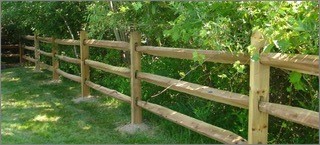
2. Paddock or estate fences, no higher than 4 feet.
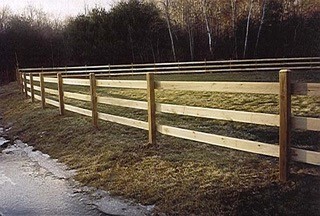
3. Picket fences, no higher than 4 feet.
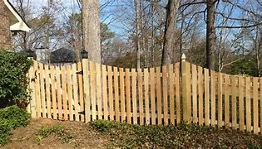
4. Stockade or board-on-board (a.k.a. shadow box) fences will be considered for the screening of hot tubs and swimming pools (see section 4.40 for more information on swimming pool). Other uses of this fencing style will be considered on a case-by-case basis.
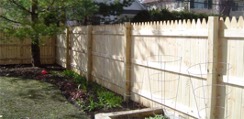
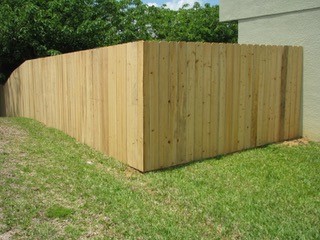
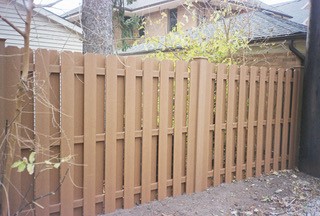
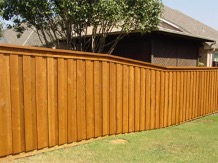
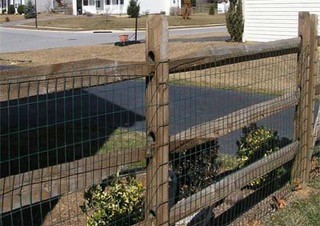
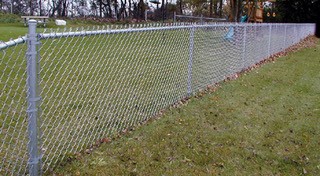
^ top ^
4.16.2 Townhouses and Condominiums
Applications must include:
4.16.3 Additional information:
Applications are not required for 3 feet by 5 feet or smaller flags on poles attached to a house, garage, carport or deck, or for small banners displayed for holidays.
An application is required for all other flags and banners.
Applications must include:
An application is not required for propane tanks to be used for outdoor grills.
An application is required for all other tanks.
Applications must include:
Approval will depend on the location of the tank, and the ability to screen the tank from neighboring properties and street views.
Exterior oil storage tanks will not be allowed.
An application is required for all gazebos.
Applications must include:
Gezebos must be compatible in materials, style, and color with the existing house.
An application is not required for portable propane or charcoal grills.
An application is required for all grills that are permanently installed.
Applications must include:
Contact the local fire department for permanent grill placement guidelines.
An application is not required to replace gutters with ones that are of the same style and color.
An application is required for all other gutters and downspouts. Above ground downspout extensions longer than six feet require application.
Applications must include:
An application is required for all hot tubs and whirlpools.
Applications must include:
Wastewater should drain into the existing plumbing of the residence, and adequate drainage will weigh heavily in the approval.
For safety purposes, a lid with a lock is recommended during periods of non-use.
^ top ^
An application may be required. (No application is required for working remotely or working solely by computer from a home office. Group homes and day care facilities do not require approval by the Wilde Lake Architectural Committee.)
The Wilde Lake Village Covenants (Section 11.02) state:
"No in-home business or profession shall be conducted in or on any part of a Lot or in any improvement thereon on the property without the specific written approval of the Architectural Committee. The Architectural Committee, at its discretion, upon consideration of the circumstances in each case, and particularly the effect on surrounding property, may permit a Lot or any improvement thereon to be used in whole or in part for the conduct of a profession or home business. No such profession or home business shall be permitted, however, unless it is considered by the Architectural Committee to be compatible with a high quality residential neighborhood."
The applicant for an in-home business must reside at the address of the proposed business, and an in-home business application does not convey from one Lot owner to another.
It is recommended that the application include the signatures of immediate property owners.
The following list of questions must be addressed on the application:
An application is required for all changes in grade, retaining walls and single species hedges. A master plan for the landscaping should be submitted with the application, even if the planting is to be done in stages.
Applications must include:
No application is necessary to create naturalistic mixed landscaping along property lines made up of a mix of trees, shrubs, perennials, and groundcovers.
It is recommended that plantings be arranged in clusters or groups, rather than in straight lines. Cluster plantings give a natural effect which is in harmony with the general plan of the Village.
No application is needed for rain gardens that have been designed and installed by Columbia Association, Howard County Cleanscapes, or certified Chesapeake Bay Landscape Professionals, because of demonstrated expertise and experience.
Wilde Lake recommends employing environmentally friendly landscaping practices. Additional information is available in our Environmentally Friendly Landscaping Practices guide (requires Adobe Reader).
An application is not required for lawn ornaments that are small in scale and those ornaments displayed briefly for special occasions and holidays.
An application is required for large objects and those objects that are intended to be displayed permanently. Each object will be evaluated on aesthetics, as well as on placement and appropriateness to its surroundings.
Applications must include:
Lawn ornaments includes all exterior decorative objects, natural or man-made, that are large enough to be noticeable from the street or from adjacent properties. These objects include, but are not limited to, such items as sculptures, fountains, large urns, ornamental pools, sun dials and large rocks.
One backyard birdbath per property is permitted without application.
An application is required when there will be a change in style, size, shape, color or location of an existing fixture or when additional light fixtures are to be installed.
Applications must include:
An application is not required when an existing light fixture is replaced with one that is a reasonable match to it.
Light fixtures should enhance the daytime appearance of the house and appear as an integral part of the design of the house and/or its landscaping.
Exterior lighting should be carefully placed to minimize its impact on adjacent properties and public spaces. Light fixtures should be oriented to illuminate only a specific area, such as a doorway. Some lights may have to be shielded to prevent excessive intrusion of light from one property to another.
All exterior lights must be shielded and aimed downward so as to illuminate the homeowner's property only. This decreases upward light pollution, though it can still negatively impact plants, insects and other wildlife. The use of low-intensity, motion-sensor lighting is strongly encouraged to minimize impact on neighboring properties, energy use, and the environment. Yellow LED light bulbs provide sufficient illumination while attracting fewer insects.
An application is not required when replacing an existing patio or walkway with one of identical materials and configuration or if the patio or walkway is completely enclosed within an existing privacy fence, as in many townhouse developments.
An application is required:
Applications must include:
Materials such as concrete, stone, brick, treated wood, composite wood or pavers are preferred.
An application is required.
Applications must include:
Play equipment (including tree houses and similar structures) should not be installed in the front yard and should be located at least ten feet from the rear and side property lines.
^ top ^
An application is required for all ponds.
Applications must include:
Ponds will be evaluated on aesthetics, as well as on placement, proportions, and appropriateness to the surroundings. A Howard County permit is required for a pond more than 24 feet deep, regardless of its dimensions.
An application is required.
Applications must include:
A screen is considered to be any permanent or semi-permanent structure that limits or eliminates viewing of a given area.
Privacy barriers/screens will be considered on a case-by-case basis, although plantings in staggered clusters are preferred instead of structural barriers.
4.31 Radon Mitigation Equipment
An application is required for units mounted on the front or street side.
No Application is required if all of the following conditions are met:
The pipe is located alongside a downspout (on the side or rear of the house only) and painted to match the downspout. Although the location alongside the downspout is preferred, it would be acceptable for the pipe to be vertically placed on the side or rear of the house and painted to match the house. Some landscaping/screening may be required.
No application is needed for one rain barrel of 75 gallons or less per downspout if the following guidelines are met.
The drainage/overflow/runoff should be properly diverted to avoid flowing onto neighboring properties. Rain barrels should be an earth tone color or match the color of the home or accents. Rain barrels must be located against the house; landscape screening can soften the visual impact of the rain barrel to neighboring properties. Rain barrels should be maintained at all times and should be free of standing water.
NOTE: HOWARD COUNTY REQUIRES THE LICENSING OF ALL RENTAL UNITS. Call 410-313-2455 for information.
Every dwelling or dwelling unit in Howard County which is not occupied solely by the owner or the owner's immediate family must be licensed if there are one or more boarders, roomers or renters occupying the dwelling. This requirement applies whether or not rent changes hands.
Property owners are responsible for covenant and maintenance compliance.
An application is required when adding or enlarging a retaining wall or when replacing an existing wall with different materials.
Applications must include:
An application is not required where an existing and approved retaining wall is being replaced with the same location, size, and materials.
^ top ^
When there will be a change in color, style and materials used, an application is required.
Applications must include:
An application is not required to replace a roof with material of the same color, style and composition as the existing roof. A change to architectural asphalt shingles of the same color and adding roof ridge vents do not require an application.
An Exterior Alteration Application is required if more than 4 cameras are to be used or for cameras to be mounted on shared carports or garages.
Applications must include:
No Exterior Alteration Application is required for security cameras if the following conditions are met:
An application is required for all sheds, whether new or replacement.
Applications must include:
Shed size should be proportional to lot size and the existing structures, and the color and materials used must coordinate with the surroundings.
If a shed is to be located near the back property line, rather than against the house, screening from neighboring properties must be provided.
An application is required:
Applications must include:
New siding shall be in harmony with the prevailing character of the buildings in the neighborhood. Variation in detail and form may be used to provide visual interest and avoid monotony. The siding of separate offset and/or shared garages and carports must match the house siding color and style.
An application is not required when there is to be no change in color or style.
An application may be required.
General
Except for temporary signs advertising the sale or rental of residential property, no sign or other advertising device of any nature shall be placed upon any Lot without the written approval of the Architectural Committee.
An application is not required for the following signs:
Political Campaign Signs
Real Estate Signs
Security System Signs
Signs Indicating Environmental Purpose:
Other signs
An application is required for all permanent new signage and for changes to existing signs.
Applications must include
^ top ^
An application is required when adding new skylights or changing the appearance of existing skylights.
Applications must include:
Fast Track Criteria:
An application is not required to replace existing skylights with ones of the same size, style, color and materials.
If the solar panel system is integrated into the design of the house, and the panels in their resting state appear flush with the roof, no application is required.
An application is required for other types of solar panel installations.
Applications must include:
Private swimming pools are strongly discouraged. Applicants are responsible for complying with all Howard County regulations concerning private swimming pools, including safety fencing and setbacks from property lines and adjacent buildings.
An application is required for all permanent in-ground and above ground pools. Landscaping, grading, noise levels and drainage will be carefully evaluated.
Applications must include:
A Howard County permit is required for a pool deeper than 24", regardless of its dimensions. Visit the Department of Inspections, Licenses and Permits' website (https://www.howardcountymd.gov/inspections-licenses-permits) or contact the Department by phone at 410-313-2455.
No application is required for children's plastic and inflatable wading pools.
4.43 Teardown/New Construction
For those homeowners who wish to demolish an existing single family home and construct a new house, a separate policy and procedure must be followed. Please contact the Wilde Lake Covenant Advisor, [email protected], 410-730-3987 for specific guidance.
Written permission from Columbia Association Open Space is required to remove any tree with a diameter of 6" or more, measured at a point two feet above ground level.
CA's Tree Removal Request form (https://www.wildelake.org/wp-content/uploads/2018/06/TreeRemovalApp.pdf - requires Adobe Reader) should be completed and submitted to CA Open Space at [email protected] (410/312-6330). An arborist will inspect the tree(s). If the tree is approved for removal, the resident will be notified by email or mail.
Problems with street trees should be brought to the attention of Howard County Bureau of Highways by submitting a request through Howard County's TellHoCo website (https://www.howardcountymd.gov/tell-hoco ) or calling 410-313-7450.
For more information, please call the Howard County Agricultural Extension Service at 410-313-2707.
Dead and dying standing trees (snags) that provide wildlife habitat are acceptable as long as they do not represent a pest or disease risk to surrounding trees, or a safety or damage hazard to surrounding properties or communal walkways, sidewalks, or streets. Pruning may be required to improve curb appeal and to maintain health and safety. A backyard location is preferred, but no more than one snag in the front yard will be allowed without application. Stumps and extended roots can remain after a tree has been removed to provide habitat and erosion control; these should form a part of a landscaped bed to improve appearance and support for wildlife.
An application is not required when the vegetable garden is located in the back of the property and does not exceed two hundred square feet.
An application is required for oversized gardens and/or those that require fencing.
Applications must include:
^ top ^